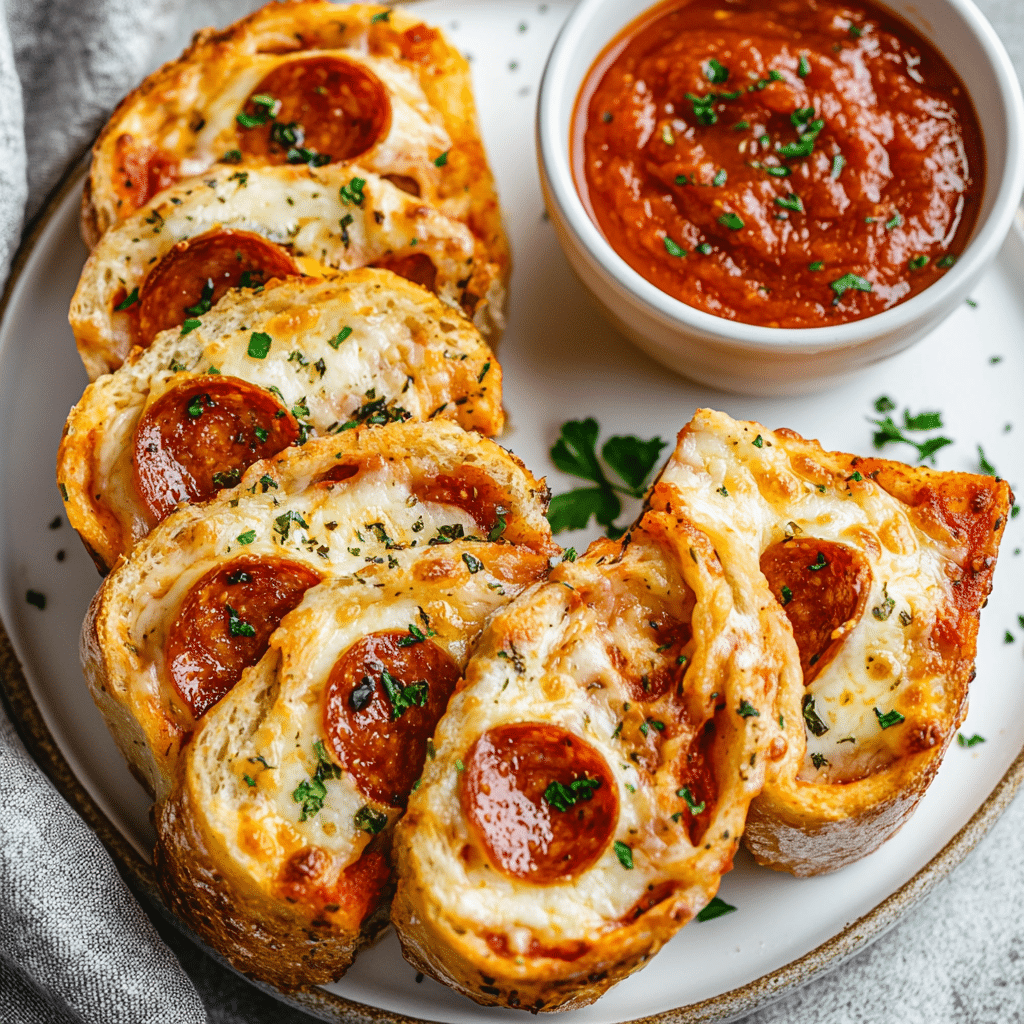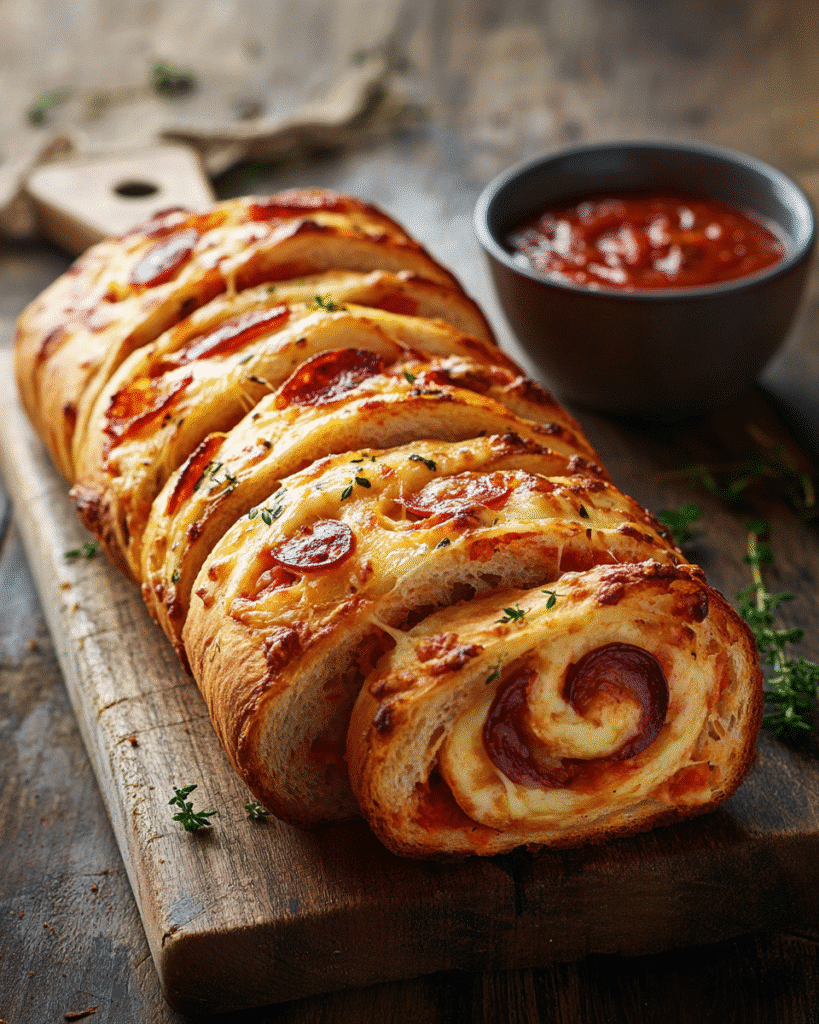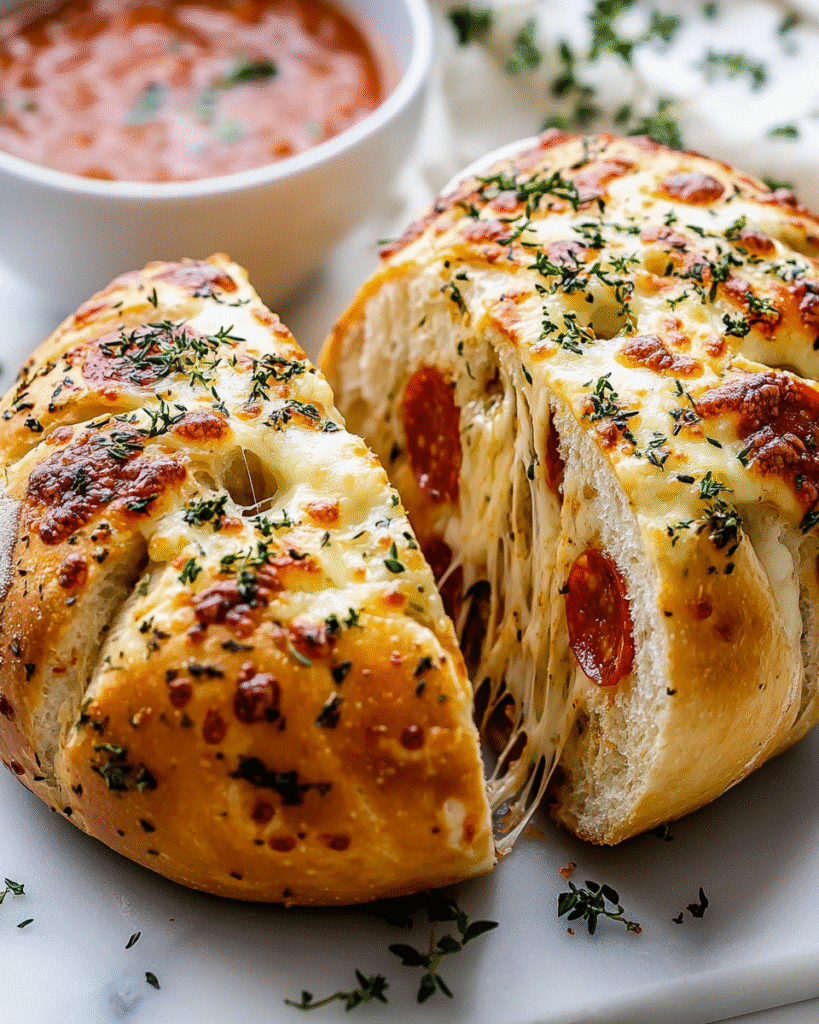Pepperoni bread has quietly won over families and food lovers alike, becoming a star dish at dinners, parties, and game-day spreads. But this cheesy favorite is more than just a fun twist on pizza—it has deep roots and a flavorful story to tell.
In this article, we’ll walk you through where it came from, how to make it step by step, and ways to switch it up with fun variations. We’ll also dive into what to serve with it, how to store leftovers, and answer the most common questions for home bakers.
Whether you’re trying it for the first time or baking it for the hundredth, this guide will help you bring out the best in every bite.

Pepperoni Bread: A Savory Delight with Rich Heritage
- Total Time: 45 minutes
- Yield: 1 loaf (approximately 8 slices) 1x
Description
Pepperoni Bread is a crowd-pleasing, cheesy, and savory treat that’s perfect for game day, parties, or a fun family dinner. Made with soft dough, layers of gooey mozzarella cheese, and spicy pepperoni slices, this easy-to-make bread is rolled up and baked to golden perfection. It’s like a rolled-up pizza, but even better for dipping and sharing!
Ingredients
Ingredients:
1 lb pizza dough (store-bought or homemade)
1 ½ cups shredded mozzarella cheese
1 cup sliced pepperoni
1 tablespoon olive oil
1 teaspoon garlic powder
1 teaspoon Italian seasoning
1 egg (for egg wash)
Marinara sauce, for dipping (optional)
Instructions
Preheat your oven to 375°F (190°C). Line a baking sheet with parchment paper.
Roll out the pizza dough on a lightly floured surface into a rectangle, about 10×14 inches.
Evenly sprinkle the mozzarella cheese over the dough, leaving about ½ inch border around the edges.
Layer the sliced pepperoni over the cheese.
Sprinkle garlic powder and Italian seasoning evenly over the pepperoni.
Starting from the longer side, tightly roll up the dough into a log. Pinch the seam and ends to seal.
Place the rolled dough seam-side down on the prepared baking sheet.
Beat the egg in a small bowl and brush it over the top of the dough for a golden finish.
Bake for 25–30 minutes, or until golden brown and cooked through.
Let it cool for 5–10 minutes before slicing. Serve warm with marinara sauce for dipping.
- Prep Time: 30 minutes
- Cook Time: 30 minutes
- Category: Appetizer
- Cuisine: American
Nutrition
- Serving Size: 1 slice (about 120g)
- Calories: 310
- Sugar: 2g
- Sodium: 690mg
- Fat: 15g
- Saturated Fat: 6g
- Unsaturated Fat: 8g
- Carbohydrates: 28g
- Fiber: 1g
- Protein: 14g
- Cholesterol: 35mg
Keywords: Pepperoni Bread
The Origins and Cultural Significance of Pepperoni Bread
From Coal Mines to Culinary Fame: The Birth of Pepperoni Bread
Pepperoni bread didn’t start in a restaurant—it was born underground, in the coal mines of West Virginia. Back in the 1920s, an Italian baker named Giuseppe Argiro had a bright idea: coal miners needed a lunch that was easy to carry, didn’t spoil, and filled them up. So he wrapped spiced meat in dough and baked it into a neat, no-fuss meal.
That handy invention, known as the pepperoni roll, paved the way for what many now know as this classic cheesy bread. It was simple, filling, and didn’t need refrigeration. Even today, it’s baked fresh in West Virginia towns like Fairmont and Clarksburg, a lasting symbol of practical creativity.
The modern version we enjoy today is a bit more dressed up. It’s typically made with rolled pizza dough, melty cheese, and thinly sliced cured meat. Every slice packs chewy texture, gooey goodness, and a bold, satisfying bite.
Regional Variations and Popularity Across the U.S.
Soon, the idea spread beyond West Virginia. In Pennsylvania, Ohio, and Kentucky, bakers began adding their own spin—some tossed in peppers or swapped mozzarella for provolone. Others brushed the crust with garlic butter or sprinkled in herbs for extra flavor.
Across the country, you’ll now find this stuffed bread in bakeries, home kitchens, and at just about every holiday table. Thanks to its simple dough base, cheesy layers, and hearty taste, it’s become a favorite savory bread recipe that anyone can whip up and make their own.
Essential Ingredients and Tools for Crafting Pepperoni Bread
Key Components: Dough, Pepperoni, and Cheese
When it comes to making great pepperoni bread, using the right ingredients makes all the difference. You don’t need anything fancy—just a few quality basics.
First off, the dough. You can use store-bought pizza dough to save time, or make your own from scratch if you like the hands-on approach. Either way, the dough should be soft but sturdy enough to hold all the fillings.
Next comes the star: pepperoni. Thin-sliced pepperoni is the most common choice, but stick pepperoni gives a bit more bite and texture. For a richer flavor, some folks mix in a few slices of spicy salami.
Don’t forget the cheese. Mozzarella melts beautifully and gives you that classic pull-apart effect. You can also try provolone, cheddar, or even a sprinkle of grated Parmesan for added depth. Just don’t overload it—you want gooey, not greasy.
Kitchen Tools for the Perfect Bake
To prep pepperoni bread with ease, gather a few simple tools. You’ll need a rolling pin to flatten the dough evenly. A baking sheet, preferably lined with parchment paper, helps avoid sticking.
A sharp knife or dough cutter is essential for clean slices, while a pastry brush is handy for applying butter or egg wash. If you want that golden crust, don’t skip the brush!
Using these tools and ingredients, you’re already halfway to making a delicious loaf that’s crispy on the outside and cheesy in the middle. Let’s keep going—next, we’ll roll, fill, and bake.

Step-by-Step Guide to Making Traditional Pepperoni Bread
Preparing the Dough and Layering Ingredients
Let’s break it down. Making pepperoni bread at home is easier than you might think. Start by letting your dough rest at room temperature for 20–30 minutes. This helps it relax and roll out without tearing.
Next, lightly flour your counter and use a rolling pin to flatten the dough into a rectangle, roughly 10×14 inches. Try to keep it even—this helps with rolling and baking later.
Now, cover the surface with pepperoni slices, leaving about a 1-inch border around the edges. Follow with a layer of shredded mozzarella cheese. If you’re adding extras like herbs or onions, sprinkle those on now.
Starting from the long side, roll the dough up tightly like a jelly roll. Press the seam gently to seal it. Then fold the ends underneath to keep the filling from escaping.
Baking to Perfection
Transfer the roll onto a parchment-lined baking sheet, seam-side down. Before it hits the oven, brush the top with melted butter or a beaten egg. This gives the bread a beautiful golden color and adds flavor.
Want to kick it up a notch? Sprinkle Italian seasoning, garlic powder, or Parmesan cheese on top before baking.
Bake in a preheated oven at 375°F (190°C) for 25 to 30 minutes. The bread should be golden brown and firm to the touch. If you’re not sure it’s done, you can tap it—if it sounds hollow, it’s ready.
Let it rest for about 10 minutes before slicing. Trust us—cutting it too soon will make all that gooey cheese spill out too fast.
Creative Variations to Spice Up Your Pepperoni Bread
Incorporating Different Cheeses and Meats
Pepperoni bread is a versatile dish that invites creativity. While the classic version uses mozzarella and pepperoni, experimenting with different cheeses and meats can elevate the flavor profile.
Consider using provolone or cheddar for a sharper taste. These cheeses melt well and add a distinct character to the bread. For a smoky flavor, smoked gouda or fontina are excellent choices.
When it comes to meats, salami, ham, or even cooked sausage can be delightful alternatives or additions to pepperoni. Combining different meats can create a rich, savory filling that complements the bread’s texture.
Remember to balance the quantity of fillings to prevent the bread from becoming too heavy or greasy. A moderate amount ensures a harmonious blend of flavors and maintains the bread’s structural integrity.
Adding Vegetables and Herbs for Extra Flavor
Incorporating vegetables and herbs can add freshness and complexity to your pepperoni bread. Sautéed onions, bell peppers, or mushrooms introduce a sweet and earthy dimension. Spinach or arugula can add a subtle bitterness that balances the richness of the cheese and meat.
Fresh herbs like basil, oregano, or thyme infuse the bread with aromatic notes. Sprinkling these herbs over the filling before rolling the dough can enhance the overall taste.
For a spicy kick, consider adding sliced jalapeños or a dash of red pepper flakes. These elements can invigorate the palate and add depth to the flavor profile.
Experimenting with these variations allows you to tailor the pepperoni bread to your personal preferences or to suit different occasions. Whether you’re aiming for a classic taste or a gourmet twist, the possibilities are endless.
Serving Suggestions and Pairings
Ideal Accompaniments for Pepperoni Bread
Pepperoni bread is a hearty dish that pairs well with a variety of sides. Serving it with a fresh green salad can provide a refreshing contrast to the bread’s richness. A simple salad with a light vinaigrette helps cleanse the palate and balances the savory flavors.
For a more indulgent pairing, consider serving pepperoni bread with a bowl of marinara or garlic butter dipping sauce. These sauces complement the bread’s flavors and add moisture to each bite.
If you’re looking for a more substantial meal, pairing pepperoni bread with a bowl of soup, such as tomato basil or minestrone, can be satisfying. The combination offers a comforting and filling dining experience.
Beverage Pairings to Complement the Flavors
Choosing the right beverage can enhance the enjoyment of pepperoni bread. A glass of red wine, such as Chianti or Merlot, complements the savory and cheesy elements of the bread. The wine’s acidity and tannins balance the richness of the dish.
For beer enthusiasts, a crisp lager or a hoppy IPA can provide a refreshing counterpoint to the bread’s flavors. The carbonation and bitterness help cleanse the palate between bites.
Non-alcoholic options like sparkling water with a slice of lemon or a chilled iced tea can also be excellent choices. These beverages offer a clean and refreshing taste that pairs well with the savory bread.
Selecting the appropriate accompaniments and beverages ensures a well-rounded and enjoyable dining experience with pepperoni bread.
Tips for Storing and Reheating Leftovers
Proper Storage Techniques
After you’ve enjoyed your fresh pepperoni bread, storing leftovers the right way helps keep the flavor and texture intact. First, let the bread cool completely at room temperature. Then wrap it tightly in aluminum foil or plastic wrap. For best results, place it in an airtight container and store it in the fridge for up to 3 days.
If you plan to save it longer, pepperoni bread freezes well. Wrap individual slices or the whole loaf in foil, then place them in a freezer-safe bag. It’ll stay good for up to 2 months.
Reheating for Best Taste
To bring back that fresh-baked taste, the oven is your best friend. Preheat to 350°F (175°C), wrap the slice in foil, and warm it for 10–12 minutes. This keeps the crust crispy and the cheese gooey.
In a rush? You can microwave it for 30–40 seconds, but note that the crust may turn soft. Still tasty, though!
Common Mistakes to Avoid When Making Pepperoni Bread
Overstuffing the Dough
It’s tempting to pack your pepperoni bread with extra meat and cheese, but too much filling can backfire. When overfilled, the dough may tear while rolling—or worse, burst while baking. This can cause your delicious fillings to leak out onto the pan, leaving you with a mess and less flavor inside.
Instead, aim for balance. Even layers of pepperoni and cheese will give you full flavor without compromising structure. If you want more filling, consider making two smaller loaves instead of one large one.
Not Sealing the Edges Properly
Another common mistake? Forgetting to seal the edges tightly. If the dough isn’t sealed well, steam can escape through the cracks. That leads to uneven baking, dry cheese, or soggy spots.
To avoid this, always pinch the seams firmly closed and tuck the ends under the loaf. You can also brush a bit of water or beaten egg along the edges before rolling—this helps the dough stick to itself and stay sealed during baking.
By avoiding these simple mistakes, your pepperoni bread will turn out better every single time—crispy, melty, and packed with flavor from end to end.

Can I Use Store-Bought Dough?
Yes, you definitely can! Using pre-made pizza dough is a great time-saver, especially if you’re new to making pepperoni bread. It gives you consistent results and saves you the effort of kneading and rising. Just let the dough come to room temperature before rolling it out—it’ll be easier to work with and less likely to tear.
Store-bought dough is found in most grocery stores, usually in the refrigerated section. It’s ideal for weeknight meals when you want something quick but still homemade. And honestly, when baked right, no one will even notice the shortcut.
Is It Possible to Freeze Pepperoni Bread?
Absolutely. Pepperoni bread freezes surprisingly well, which makes it perfect for prepping ahead of time. Once baked, let the loaf cool completely. Then wrap it tightly in aluminum foil and place it inside a freezer bag. You can freeze the whole loaf or individual slices.
When you’re ready to enjoy it again, thaw the bread overnight in the fridge. To reheat, pop it in the oven at 350°F (175°C) for 10–15 minutes until warmed through. It’ll taste almost as good as the day you made it—and sometimes even better.
